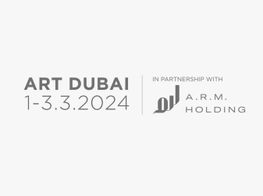The Top Five Booths at Art Dubai 2015

In its ninth edition, Art Dubai came and went in a flash. Amid 92 galleries, talks, new discoveries of works and artists, there was an underlying sense that the fair was coming into its own. Art Dubai, along with the Sharjah Biennial have led and informed the art scene in the UAE for the last few years. Now, with the expansion of Alserkal Avenue and the imminent opening of the first museum in Abu Dhabi, the fair not only attracts curators and collectors from around the world but also has a growing infrastructure across the city to support it. As the fair matures, it moves closer towards one of global and regional relevance and importance, bringing access to artists, curators, writers and works that may otherwise be overlooked. From conversations with gallerists and dealers who have been on the trail from Armory (with its Middle East focus this year) and Art Basel in Hong Kong, it was understood that whilst sales may not have been fantastic, this year’s Art Dubai brought a fresh set of conversations that were perhaps lacking at the other fairs, where the same faces tend to appear. The UAE art community works steadily towards March every year, throwing all its energy into the process. The teams are knitted into the community, stitching together the systems and processes that in the future will allow the community to grow and take root and at the end of ‘Art Week’ it's another positive step in the right direction.
Here is a summary of some favourite booths, in order of preference and with a focus on the solo installations.
Carroll/Fletcher, London
With over seventy-eight museum groups set to come to the fair, Carroll/Fletcher’s presentation was both considered but also the most ambitious in the contemporary sector, clearly targeted at collections and institutions. Rafael Lozano-Hemmer's interactive installation at once differentiates and unifies the individual, challenging current notions of identity and socially stratifying systems. One fingerprint, entirely original and pulsing to its own beat, when fed into the work stacks against the weight of all the other anonymous ‘independents’—we are at once aware of an unnerving surveillance but also a visual liberation of these truths, basking in the rich, pink and warm uteral incubation of the booth. Pulse Index records participants’ fingerprints at the same time as it detects their heart rates—it displays data for the last 10,925 participants, creating a spiral room of skin. To participate, people introduce their finger into a custom-made sensor equipped with a 220x digital microscope and a pulsimeter; their fingerprint immediately appears on the largest cell of the display, pulsating to their heartbeat. As more people activate the piece, one’s own recording travels sideways and is reduced in size until it disappears altogether. The work was under consideration by collections in the USA, Australia and regionally.
Rafael Lozano-Hemmer, Pulse Index, 2010The second work, which stood outside the booth, was Please Empty Your Pockets, 2010. A conveyor belt with a computerised scanner that records and accumulates everything that passes under it, allowing viewers to place any small item on the conveyor belt—once they pass under the scanner, the objects reappear on the other side of the conveyor belt beside projected objects from the memory of the installation—it saw a constant crowd waiting to interact with it. As a real item is removed from the conveyor belt, it leaves behind a projected image of itself, which is then used to accompany future objects. The piece remembers up to 600,000 objects which are displayed beside new ones that are added to the installation.
Rafael Lozano-Hemmer, Please Empty Your Pockets, 2010Lozano-Hemmer's works are installation based and often at the intersection of architecture and performance art. His main interest is in creating platforms for public participation, by perverting technologies such as robotics, computerised surveillance or telematic networks.
Rafael Lozano-Hemmer has a solo exhibition upcoming at MUAC Museum, Mexico City, from October 2015 to March 2016, along with several other institutional projects including Madison Square Park Gala, London Book Fair, and Aesthetica 50 Years of Computer Generated Art at DAM Gallery, Berlin.
Isabelle van den Eynde, Dubai
Isabelle van den Eynde had a solo presentation of Emirati artist Mohammed Kazem alongside Ramin and Rokni Haerizadeh and Hesam Rahmanian. The booth was split in two, and on one side of the wall was the collaborative work by Rokni and Ramin Haerizadeh and Rahmanian. On the other side of the wall was the minimal presentation of Kazem. The later's was of particular note, with pieces dating from the 70s providing a unique introduction to his practice for the unfamiliar. Kazem was born in Dubai, UAE, in 1969 and is a trained musician as well as a pioneering conceptual artist. Influenced by his close friend and mentor Hassan Sharif, his work touches on current global transformations in the social, political, and natural environments, and explores abstract ideas about the body, movement, space, and the natural elements. Kazem will take part in the UAE pavilion at the Venice Biennale.
Mohammed Kazem at Isabelle van den EyndeChristopher Lord, Artistic Director of IVDE said of the booth: “The Mohammed Kazem booth was really about showing how certain key ideas have underpinned Mohammed's practice since the mid-90s and that there is a playful, very conceptual engagement that continues today. The booth for Ramin, Rokni and Hesam really aimed to show how their collective functions living and working together in Dubai - blurring the individuality of the three artists. The works on that booth really gravitated around the idea of tracing - with the three making their own distorted 'waxworks'.”
Rokni and Ramin Haerizadeh and Rahmanian at Isabelle van den EyndeThe solo or duo presentations on the whole allowed for a more involved experience of the work, a hook in what can otherwise be a fast paced, surface level engagement with the art.
Meanwhile at the gallery, IVDE had another Emirati artist on show—Hassan Sharif. Again, it was exciting to gain access to locally based artists and to build a picture of what is being made in Dubai. Sharif's work will also form part of the UAE pavilion at the Venice Biennale, the exhibition 1980 – Today: Exhibitions in the United Arab Emirates will explore the emergence of contemporary art practices in the UAE over the past four decades and is curated by Sheikha Al-Qasimi, director of the Sharjah Art Foundation and Biennial.
Galerie Daniel Templeton
Galerie Daniel Templeton brought a recent series by Jitish Kallat, here after here after here (2015). This suite of new drawings, videos and photo-pieces interweaves the themes of time, recurrence, sustenance and evocations of the celestial. Having recently curated the Kochi-Muziris Biennale 2014, it was apt timing to see some of the themes integral to the biennale’s curation played out within his own work—the Kochi-Muziris Biennale closed just recently. Where the familiar at first seems unrecognisable, through a slow revelatory process, an assembly of visual conundrums and metaphoric associations emerge, each imbued with deeper meaning. The raw pencil scratching, marks, burns and imprints in the suite of fifteen drawings titled Wind Study (the hour of the day of the month of the season), are evocative of unknown neural networks or sacred geometries—each seemingly a potent device to read the forces of nature that inhabit the space and time of the artwork. The video Forensic Trail of the Grand Banquet invokes a journey through space wherein planetary and stellar formations, galactic clusters and nebulae are replaced by hundreds of X-ray scans of food. In the video Infinitum (here after here) 30 rotis (round Indian breads) are morphed with the waxing and waning images of the moon, connecting notions of the body, sustenance, the astral and the sky. The circular photo-piece titled the hour of the day of the month of the season appears like the sighting of planetary constellations during a satellite grab. A closer view reveals the image to be a medical X-ray output of platters of food.
Jitish Kallat at Galerie Daniel Templon. Courtesy the artist and Galerie Daniel Templon, ParisWith his simultaneously ironic yet poetic approach, Jitish Kallat brings back the spiritual at the heart of material considerations. The curation of the booth responded to the conceptual basis of the work, with the artist being instrumental to hanging each piece, in a sequence that ties you into its core. From the selection, three pieces sold circa $10,000 with another three on reserve.
Kurimanzutto
Showcasing a number of different works was Mexico City’s newcomer to Art Dubai, Kurimanzutto. Bringing largely South American work, they reported positive sales, with the main Allora and Calzadilla’s Shape Shifter (2015) going to a local collector they had met for the first time. Allora and Calzadilla have a show upcoming at Dia: foundation projects in Puerto Rico in September. In the mix, the gallery brought five artists who are also showing at the current Sharjah Biennial, giving them another good reason to attend and potential collectors another entry point for the works. Artists at Sharjah included Damián Ortega with exhibitions upcoming at MAM, Rio De Janeiro in April and Hangar Bicocca, Milano in June; Abraham Cruzvillegas who has an upcoming commission at Tate Modern’s Turbine Hall, London in October; Rikrit Tiravanija, Danh Vo and Adrián Villar Rojas who shows at Moderna Museet, Stockholm this March and Centre Pompidou, Paris in June.
Exhibition view, KurimanzuttoGabriel Orozco, who is currently at Tokyo’s Contemporary Art Museum, showed Semilla corriente (Stream seed), Hacha vagina (Yoni ax), Canto con gotas (Rain drop cycle), Gota triple (Triple drop) from 2013 along with some earlier untitled works from 2003. Subtle graphites on paper balanced the series of river cobble stone sculptures, taken from the Guerroro coast and carved to draw out their yonic and phallic characteristics.
Kaveh Golestan
From the Modern section, were Kaveh Golestan’s Polaroids as part of the non-profit projects programme. Vali Mahlouji has charged himself with curating, archiving and exhibiting the Iranian photographer’s work, with access to over 500,000 unseen negatives. The series entitled Az Div o Dad made circa 1976 are a rare and important series of works unseen since 1978. Golestan, an artist now more recognised for his documentary photography, created a series of innovative and striking Polaroids by moving collaged fragments in front of an open shutter over long exposures.
Kaveh GolestanThe process created fantastical and surrealistic works that blend fairytale and history. The images are visions of anthropomorphic figures set against natural and architectural backgrounds with references to modern and Qajar era histories. These works open a window onto an experimental side of Golestan’s practice, which has received little critical exposure to date. The Az Div o Dad series is accompanied by a display of original artworks and collages, which shed light on the processes involved in the creation of the final Polaroids.—[O]
















